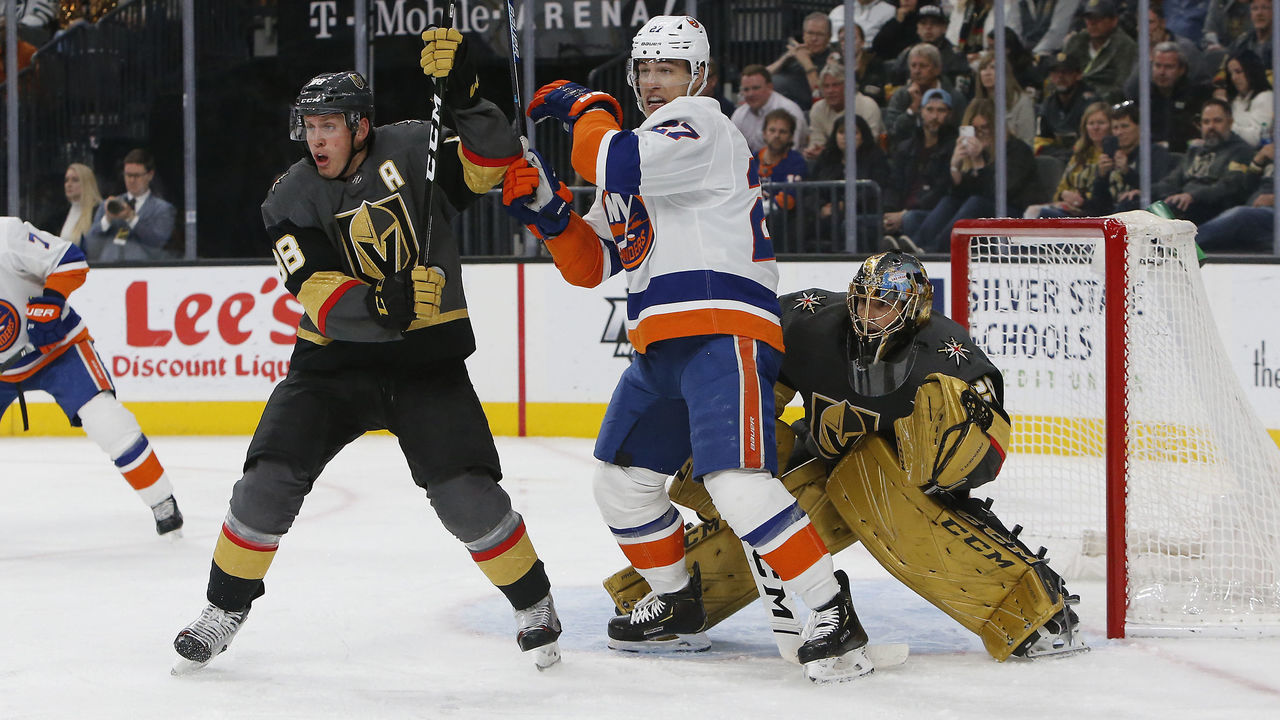Travis Dermott looked down at the dressing room floor for a moment before staring at the questioner with a curious grin.
"This is deep," said the 23-year-old Toronto Maple Leafs defenseman.
Dermott had just been asked a very specific question: What's the hardest skill or trick to master, the most difficult thing for you to do on the ice, as a professional hockey player?

It's a simple yet loaded inquiry. By the time NHLers reach the pinnacle of the sport, most hockey-related skills are second nature. But no player, not even Connor McDavid, has mastered every aspect of the game. There's always something to work on, a skill or trick that still regularly stumps them.
"High-flipping a puck really consistently is a pretty sought-after skill," Dermott said after some reflection. "I could be better at that."
Dermott then referenced a sequence in the Maple Leafs' Jan. 2 victory over the Winnipeg Jets. Handling the puck deep in his own end with 13 seconds left in the first period, he flung a Hail Mary pass to streaking teammate William Nylander. The puck traveled over the heads of three Jets players and found Nylander. He couldn't corral the bobbling rubber disc, killing the rush.
"That's it," Dermott said, locking in his answer. "Getting high flips to land flat."
In the months following that January conversation with Dermott, theScore posed the same question to several of his NHL peers. Here are some of the best answers and explanations as training camps ramp up ahead of the 24-team postseason:
Practice makes perfect

Fact: Nobody has tipped more shots on goal than Anders Lee since the 6-foot-3 center made his NHL debut on April 3, 2013. The New York Islanders captain has scored 38 goals from 214 recorded tips, trailing only Chris Kreider of the New York Rangers (42) in tipped tallies over that period.
One would think Lee has the net-front playbook mastered. Not so, he says, noting that freeing himself from defenders to find perfect tipping positioning at the perfect moment is a skill he still polishes during practice.
"It's timing, right? And you've got to be careful with pushing off," Lee said. "There's a little bit of gamesmanship in front when shots are coming through from the point. If I see (teammate Mathew Barzal) rolling off and I think he's shooting, then it's a small jab or a turn of my body the right way.
"At the same time, you have to screen the goalie and then find the rebound. There's a lot of moving parts. Sometimes you do two of the three things and it goes in. Sometimes you don't do any of them and the puck doesn't go in."
Emulating Lidstrom
Keep your head up, kid!
It's a coaching order usually reserved for young players carrying the puck into dangerous areas of the ice. But the phrase has another meaning for Calgary Flames defenseman Noah Hanifin: Keep your head up, kid, when you walk the blue line.
"You look at a guy like (Hall of Fame defenseman Nicklas) Lidstrom and he was probably the best at it - ever," Hanifin, 23, said. "He would walk the line and take a slapper, and he'd have his head up the whole time so he could find the guys who were looking to tip."

Hanifin, the fifth overall pick of the 2015 NHL Draft, played in all situations during the 2019-20 regular season, earning 21:10 of ice time a night. Skating has always been his calling card and he has decent puck skills; a change of habit - head up! - while handling the puck at the point could go a long way toward increasing his middling production (22 points in 70 games).
"It's a practice thing. I mean, it is hard, not an easy thing to do," he said. "But Lidstrom got a lot of his goals and points by having that ability to see everything while he was walking the line. He kept his head up. Erik Karlsson does it really well, too. I think that's something I want to master."
Quick feet, quick hands, quick mind
Ask 100 scouts to identify the one thing that vaults McDavid above other NHL stars, and you'll likely get a unanimous vote for his propensity to do everything at warp speed.
McDavid can blaze down the ice at upwards of 30 mph, and he consistently keeps his brain and hands operating at a similar rate. This triple-whammy of quickness is the envy of players across the league, according to forward Evander Kane, whose San Jose Sharks were victims of McDavid's brilliance earlier this season:
"If you ask any player, that's almost impossible to do," Kane said. "Because when you have the puck on your stick, you have to concentrate a little bit more, with people trying to hit you. Yet you have to have your head up. So to stickhandle with your head up and to go as fast as possible, that's what separates McDavid from everybody else, by far."
The two-time 30-goal scorer continued: "In the NHL, whether it's a first- or fourth-line guy, everybody has hands. But can they use their hands to the best of their ability with any sort of speed? That's the key. That's the really hard part."
Outsmarting the forecheck
By Tyson Barrie's estimation, there's an optimal mindset for the puck-retrieving NHL defenseman trying to elude a pesky forechecker, and it starts with assessing the zone and controlling the sequence of events.
Easier said than done.
"You try to read where the forechecker is, where your D partner is, where your outlet - the forward - is. All while trying to not get put through the end wall," the Maple Leafs defenseman said. "If you can get the net (involved) with the puck (on your stick), they should never get the puck from you. But that's not always the case. It's just the ideal scenario."

Barrie has dressed for a total of 554 NHL games across eight seasons with the Colorado Avalanche and the Maple Leafs. He's learned over the years to avoid being predictable and, under some circumstances, to allow the forechecker to make the first move.
"Instead of going 100 miles an hour back to the puck, it's better to almost let the guy ride you in and get a feel for where he's going and try to use his body to push off and go the other way," he said of the cat-and-mouse interaction between forwards and defensemen.
"They're reading off you, essentially, so if you can give them some misinformation, you're going to be able to beat them if they bite on it. If not … "
Clean shots, every single time
Rod Brind'Amour has called Warren Foegele "a perfect Carolina Hurricane." The head coach's compliment stems from the winger's honest game.
Part of what makes Foegele effective is his mobility on the defensive side of the puck. He strives to always get a piece of himself or his equipment into passing and shooting lanes, leaving little or no room for creativity from the puck carrier. His job, in essence, is to disrupt any offensive momentum by the opposing team.
But when Carolina has the puck, escaping the grasp of a harassing defender and firing an unabated shot on goal can be a troublesome undertaking for Foegele - and, truthfully, for every other NHLer who doesn't fall into the "elite offensively" category.
"Someone who's really good at separating the puck from his opponent is Nathan MacKinnon," Foegele said.
"Yes, he's so fast, everybody can see that, but he separates himself when he has the puck with this quick, shifty movement by changing the angle of the puck. He finds a way to get that clean shooting opportunity. His edgework is really good, too, which allows him to do that more frequently and effectively."
In the clip below, MacKinnon is forced to cut to the middle of the ice to find a spot from which to shoot, and he does so with incredible ease:
Bend it like Kucherov
Kevin Shattenkirk entered the league in 2010 as a 21-year-old defenseman for the Avalanche. In the decade since, through stints with the St. Louis Blues, Washington Capitals, Rangers, and Tampa Bay Lightning, he's witnessed an evolution of sorts.
"Guys are doing things that I've never done before," he said.
In particular, Shattenkirk often shakes his head at the goal-scoring tricks he sees from Lightning teammate Nikita Kucherov.
"He has this little hitch in his shot that he uses as deception. I know that I've tried to do it in practice, but I certainly don't have it. That would be one (difficult-to-master) skill," Shattenkirk said. "You can see some examples of it, off the power play on the half wall, the way he works it. It's this little kind of fake shot, push, and release it quickly."

Kucherov, who followed an incredible 128-point campaign in 2018-19 with 85 points in 68 regular-season games this year, routinely terrorizes defenders with his deceptive ways.
"He has a defenseman in front of him, he's almost stationary on the half wall or the top of the circle, and he'll drop his shoulder, fake the shot to get the defenseman to freeze up," Shattenkirk said. "And then he pushes it to the inside and shoots around him. It's a very quick and - for him - smooth play.
"In doing it, he gets a screen from the defenseman, and he freezes both the defenseman and the goalie. It's pretty amazing."
Creating from the point
Jakob Chychrun enjoyed the best regular season of his young career in 2019-20. Finally healthy, he asserted himself well, taking advantage of more than 22 minutes of ice time per night to post strong counting stats and underlying numbers for the Arizona Coyotes.
Still missing from the defenseman's arsenal, though, is the ability to consistently get shots off quickly from the point, pouncing on the puck and firing it through a sea of bodies to the net in the manner of Brent Burns of the division rival Sharks.
"I don't know how he does it, and it plays right into their system," Chychrun said of the 2017 Norris Trophy winner. "In the O-zone, all of their forwards rim pucks (around the boards). They'll be in the corner and they'll rim it around, all the way around the wall to the other side of the ice, and Burns is just sitting there."

It seems relatively straightforward when broken down step by step: Pick the puck up off the boards, immediately switch to a shooting posture, and fire a shot on net. But in real time? With nine other skaters and a goalie all occupying the same third of the rink? Good luck.
"That's a hard skill, actually: to get a puck off the wall on your forehand and get it off quick," Chychrun said. "That's something he does so well."
Next-level one-timers
Considering Alex Kerfoot has logged a mere 14 slap shots through 222 career NHL games, it's safe to say he's hesitant to unleash one-timers.
"It's something that I'm horrible at - I am really horrible at - and I'm trying to work on it," said the 5-foot-10, 185-pound Maple Leafs forward.
Kerfoot then praised all-world sniper and teammate Auston Matthews, former 60-goal scorer Steven Stamkos, and Alex Ovechkin - the ultimate marksman whose one-timing expertise is on clear display below - for finding ways to execute even when receiving an imperfect pass.
That ability to fire a one-timer when the puck is "anywhere around them" is what separates the three superstars from their NHL peers, Kerfoot said. Ovechkin, in particular, can seemingly guarantee his one-time howitzer makes its way to the opposing goal no matter how inaccurate the pass.
"It's really hard when the puck's not in your sweet spot or not perfectly in position," Kerfoot said. "Really hard to get good contact on the puck, and then to put it where you want to put it. And those guys can do it better than anyone."
The flashy flip

There is something Noah Dobson would never think about trying in an NHL game, even if the extremely rare opportunity presented itself.
"Just looking around the league and seeing all of the guys doing the plays behind the net, where they're picking up the puck and going high," the young Islanders defenseman said.
The lacrosse-style goal made famous this season by Hurricanes winger Andrei Svechnikov - who tallied twice on behind-the-net trick shots - is extremely difficult to accomplish, even in practice.
"I've tried it a couple of times, and I haven't even been close to it," Dobson said with a smile.
John Matisz is theScore's national hockey writer.
Copyright © 2020 Score Media Ventures Inc. All rights reserved. Certain content reproduced under license.